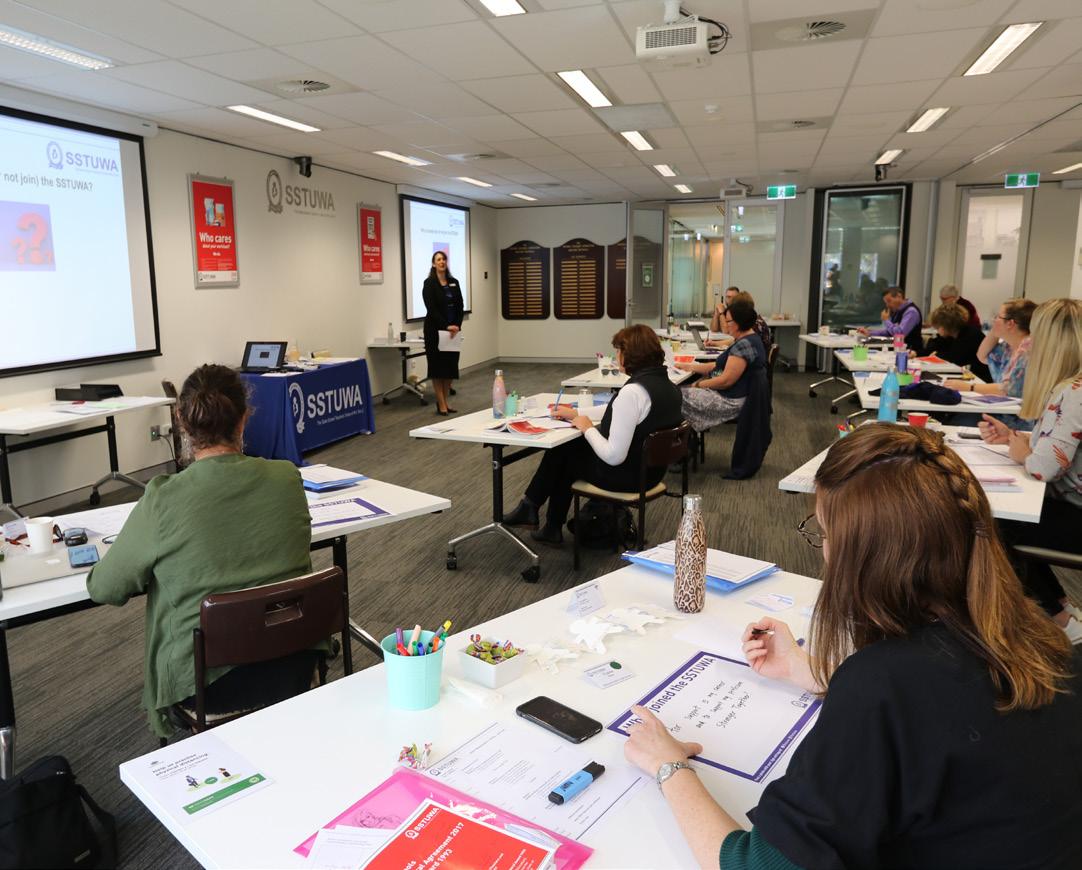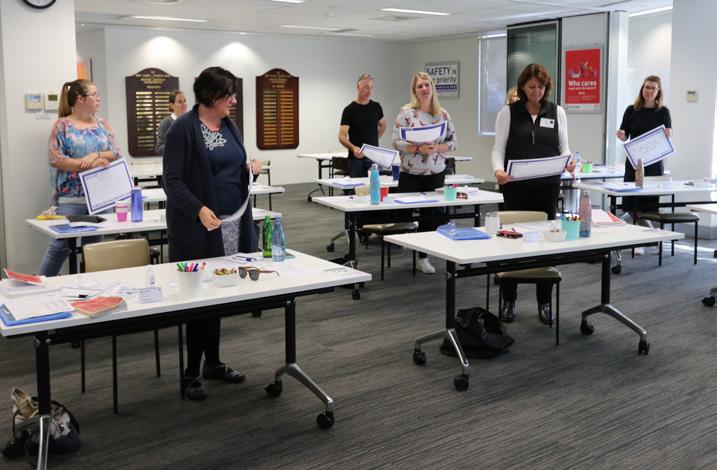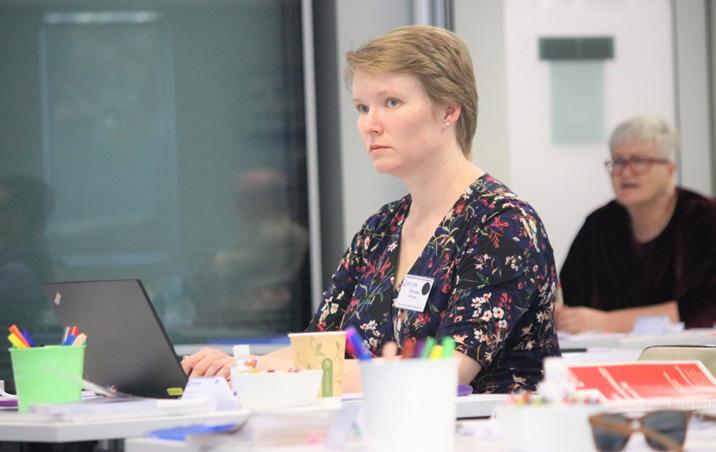
19 minute read
Don’t let politicians interfere in the classroom
Issues Don’t let politicians interfere in the classroom
It is the responsibility of public authorities to set general objectives and targets for their education systems. Schools and educators, however, must be autonomous in applying educational methods and in selecting the teaching and learning materials that will help them reach those targets.
Advertisement
Politicians should not interfere in the work of professional educators by prescribing educational methods and content.
In the United Kingdom in the late 1990s, education became an election issue. Politicians, rather than providing budgetary support and frameworks for education policy – their traditional roles – began proposing laws to manage the classroom.
A heavy reliance on testing was imposed. This created enormous stress for students and teachers, and the quality and scope of education deteriorated as its results were judged based on limited and measurable criteria.
The result of political meddling in education was that public support for the schools declined. It became difficult to recruit and retain teachers. Standards deteriorated and, as private schools assumed a greater role, schools became increasingly segregated, both ethnically and socio-economically.
As in so many policy areas in recent decades, many politicians have developed more trust in the market than in the public policy and infrastructure for which they are responsible. Unfortunately, many reforms, starting with those in the United States and the United Kingdom, have the effect of decentralising education to the school level while offering school choice and making education a matter between customers (parents) and education service providers.
The system can be damaged in a short period of time and become vulnerable to private hustlers who are better at flashy public relations and deceptive promises than at substance and real performance. In some cases, the “merchants of education” seem to do rather well when politicians invade the classroom (even if it is only for short photo opportunities). Cuts in public support for education and austerity programs adopted by these very same politicians, have created problems that, in turn, have prompted cheap and poor-quality solutions. More and more problems are caused by such solutions.
Education, by its very nature, is a longterm process. It requires consistency, solid democratic values and sustainability. It has worked best where its mission reflects a consensus in society and when it is firmly rooted in the community.
Politics are driven by an entirely different dynamic. Long-term is, normally and understandably, the next election. Results must be short term, which means that they are not likely to be real. Increasingly, politicians have become more preoccupied with slogans than substance.
When these bad habits are imposed on education, the results are disastrous. In many countries, education policy has become polarising and short-term rather than unifying and long-term.
If politicians wake up and re-assume their responsibilities to ensure education as a common good that nurtures democratic society and human rights values, misguided education reforms can be reversed. However, in the current environment in many countries, it means that creating a coherent and workable system will be much more difficult. It will require democracy to return to education. It will also need politicians who are ready and willing to serve and further that democracy.
Although it is the purview of politicians and public authorities to take decisions – even unwise ones – on educational reforms and targets, direct interference in the classroom, telling teachers what and how to teach, is crossing the line. Chapter 4 of On Education & Democracy (2019) briefly addresses the crusade against the teachers of Brazil by President Jair Messias Bolsonaro.
He believes that Marxist ideology is being taught in schools and encourages students to videotape their teachers and shame them on social media. Once in office, his Education Minister instructed schools to have students sing the national anthem and recite Bolsonaro’s campaign slogan every morning.
In Turkey, after the failed military coup in 2016, President Recip Erodgan fired 11,000 teachers and withdrew the teaching licences of 21,000, accusing them of being disloyal to his government. In addition, he removed the theory of evolution from the curriculum in primary and secondary schools.
In Hungary, President Orbán has taken control of school textbooks and they are increasingly showing a narrow nationalistic view. In 2018, he also forced the Central European University to close its doors.
In Italy, Mateo Salvini, the country’s extreme right leader, wanted to ban a university textbook in political science that branded his Lega Nord (Northern League) party as “far right”. In May 2019, a teacher from Palermo was suspended for two weeks with half pay after her students had compiled a video in which they compared Salvini’s migration laws with the racial laws promulgated by Italian dictator Mussolini in 1938. Francesco Sinopoli, general secretary of the Italian education union Federazione Lavoratori della Conoscenza (FLC CGIL) wrote in the Italian Huffington Post (17 May 2019) that with the disciplinary measure taken against the teacher from Palermo the entire Italian school system had been punished, affecting “its freedom to educate and instruct, its freedom of thought, and its ability to teach the reality of the world.”
In Germany and in The Netherlands, rightwing populist parties have established internet platforms where students are invited to report left wing “indoctrination” by their teachers. Although public opinion in these countries does not support these initiatives, they are intimidating, as well as a sign of weakening support for democratic and human rights values. The “Purple Friday" movement, which promotes a safe space for LGBTI students in schools, has been labelled by some politicians as “indoctrination”, as has been the case with teaching climate change.
In Canada, Ontario populist leader Doug Ford went after student unions who were spreading “Marxist nonsense”. He also suggested to parents that Ontario’s schools’ sex education was “too progressive”.
And as the cherry on the cake, on 12 February 2019 at a campaign rally in El Paso, Texas, the son of the president of the United States, Donald Trump Jr, encouraged his young audience to “Keep up that fight, bring it to your schools. You don’t have to be indoctrinated by these loser teachers that are trying to sell you on socialism from birth. You don’t have to do it.”
The above text is an excerpt from On Education & Democracy (2019) by Susan Hopgood and Fred van Leeuwen. The book contains 25 lessons from the teaching profession for educators. This is one of six lessons that has been identified by the SSTUWA as a key organisational objective following November State Council Conference 2019. This article has been edited for clarity and brevity. The full article and book can be read at: bit.ly/2w4kNvW
Issues Workplace sexual harassment still rife
By Kirsty Henderson
Sexual harassment in the workplace is rife and our current workplace laws are failing to keep workers safe, an inquiry led by the Australian Human Rights Commission (AHRC) has found. Sex Discrimination Commissioner Kate Jenkins has led the world’s first inquiry into workplace sexual harassment, which has found 71 per cent of people have been sexually harassed at some point in their lifetime. The Respect@Work: Sexual Harassment National Inquiry Report was released after an 18-month probe spurred on by the #MeToo movement. The Commission has acknowledged workplace sexual harassment is in every workplace, labelling it as “prevalent and pervasive”. In 2018, “workplace sexual harassment was estimated to cost the Australian economy approximately $3.8 billion,” the report stated. “Women are still most at risk, but we also heard from men who’d been harassed at work,” Ms Jenkins said. “Sexual harassment is not a women’s issue: it is a societal issue, which every Australian, and every Australian workplace, can contribute to addressing.” The AHRC received 460 submissions from government agencies to business groups, community bodies and victims. More than 600 people, both metro and regional, across all states, took part in consultations with the Commission. As part of the review, the SSTUWA contributed to the national inquiry through the Australian Education Union federal office. In 2018, the AEU conducted a national online survey of its members to investigate workplace sexual harassment across the education profession. The AEU represents 187,000 members employed across schools and TAFEs across Australia, and 1,947 members took part.
State/Territory Dept of Education
Victoria
New South Wales
Formal (Stand Alone) Sexual Harassment Policy
Yes
No
Sexual Harassment Directly Covered Under Alternate Policy/Procedures
N/A
Staff Complaints Procedures. Toolkit Assessment Tool. Allegations of Bullying, Discrimination and Harassment.
Policies of Note
Department of Education – Code of Conduct (does not specifically mention sexual harassment).
Queensland No
Australian Capital Territory No Preventing Workplace Bullying, Sexual Harassment and Unlawful Discrimination. Managing Employee Complaints.
Teacher Code of Professional Practice. ACT Public Service Respect, Equity and Diversity Framework. Department of Education – Code of Conduct (does not specifically mention sexual harassment).
Tasmania
South Australia Northern Territory No
Yes No
Western Australia No Discrimination and Harassment Policy. N/A Bullying, Harassment and Violence. Inappropriate Workplace Behaviour by DET Employees. Equal Opportunity, Discrimination and Harassment Policy. WA Department of Education Grievance Framework. Department of Education Code of Conduct.
Table 1 - State and Territory Department of Education Sexual Harassment Policy/Procedures
The survey found that 80 per cent of respondents who have experienced sexual harassment in their career are women.
The report also found that out of the 69 per cent of members who witnessed workplace harassment, only a mere 13 per cent of bystanders intervened. On a national scale, there is still more work to be done and Western Australia is lagging.
Current policy and procedures reveal that only two out of the eight states and territories provide adequate measures for dealing with sexual harassment in the workplace.
An overwhelming, “majority of the state and territory Departments of Education do not have a sufficient, stand-alone sexual harassment policy that proactively prevents sexual harassment or effectively responds to the occurrence of it in the workplace,” the AEU report said. And not only this, but that all education departments across states and territories lacked national consistency around sexual harassment policies. It was also confirmed that 75 per cent of respondents felt their employer was not doing enough to prevent sexual harassment in the workplace. Since 2003, the AHRC has led four national periodic surveys on sexual harassment and in a recent survey in 2018 it found, “one in three people experienced sexual harassment at work in the past five years.” “Aboriginal and Torres Strait Islander people were more likely to have experienced workplace sexual harassment than people who are nonIndigenous,” the AHRC said. “There is an established body of evidence that shows that male-dominated workplaces have a higher prevalence of sexual harassment.” UnionsWA has commented on a report by the WA Auditor General that is critical of the licensing for asbestos removal and handling by WorkSafe WA. UnionsWA Assistant Secretary Owen Whittle said there were many concerns raised from the Regulation of Asbestos Removal report. “Working West Australians and the public rely on a strong cop on the beat to ensure the safe removal and handling of asbestos,” he said. “This report highlights staggering deficiencies in how we regulate and licence asbestos removal in this state and should lead to substantial reform. “The history of asbestos mining in WA has left our state with an enormous legacy of buildings containing this lethal substance. “The danger from asbestos is greatest in its removal and handling which risks the creation of harmful asbestos dust. “There is no safe levels of asbestos exposure and every step needs to be taken to ensure that the health of The findings from the inquiry suggest “The current legal and regulatory system is simply no longer fit for purpose,” Ms Jenkins said. There is a strong need to shift from the current reactive approach, to a complaints-based approach, along with a focus on prevention. The report made 55 recommendations. Among them, clarification of the legal system that will see “… coordination, consistency and clarity between the antidiscrimination, employment and work health and safety legislative schemes.” The new approach would also ensure children and young people receive schoolbased respectful relationships education, and that tertiary and higher education providers deliver information and training on sexual harassment for staff and students. Other recommendations included: • Stronger OSH laws. • A revised and simplified complaints process. • Stronger powers for the
Commissioner to investigate industries with workers most at risk of sexual harassment. West Australians is protected.” The Auditor General in their report has pointed to significant problems with WorkSafe's compliance and regulatory activities including: • “There are significant gaps in
WorkSafe’s processes and practices which limit how effectively it regulates asbestos removal licensing in Western
Australia.” • “Regulatory actions are not risk-based, documentation is weak, and there is a lack of rigour and transparency in licensing approval controls…there are significant deficiencies in WorkSafe’s overall monitoring and compliance activities.” • “WorkSafe does inspect worksites when it receives notifications about friable asbestos removal work ...WorkSafe is also missing important opportunities to use asbestos-related data from the community and other government entities, including a large volume of complaints received, to better target its compliance and The development of a new framework for workplaces that is victim centred.
Research has established that victims suffer both short and long-term health effects of sexual harassment including, but not limited to, stress, depression, anxiety, post-traumatic stress disorder, along with various chronic diseases such as obesity, cardiovascular disease and even some cancers.
Ms Jenkins said Australia had an opportunity to be a leader and exemplar for other nations.
“Australia now lags behind other countries in preventing and responding to sexual harassment,” she said.
“There is the urgency for change. There is the momentum for reform.” The SSTUWA and AEU is calling on the Morrison Government to implement these recommendations in full.
To read the Respect@Work: Sexual Harassment National Inquiry Report in its entirety visit bit.ly/2yC31SH and for more information on the AEU submission into sexual harassment in the workplace, visit
Asbestos regulation critical
bit.ly/2X7ltKR
awareness raising activities.” • “Regulations under work health and safety laws has to be matched by strong enforcement.” Mr Whittle said that under the previous WA government there were significant funding cuts made to WorkSafe. “While there has been a welcome increase in funding in recent years it’s clear that more needs to be done to ensure WorkSafe can perform its basic functions,” he said. “This report comes after the WA Coroner released a report on a workplace fatality highlighting significant problems with WorkSafe’s internal processes. “While these reports may, in part, reflect past inadequacies, what is needed now is a clear commitment by WorkSafe and government to give the community confidence about the safe removal of asbestos.” The WA Auditor General’s report Regulation of Asbestos Removal is available online at: bit.ly/2ZsVWyv
Seen around Union face-to-face training returns
After a pause due to the COVID-19 crisis, the SSTUWA welcomed back members to the union headquarters for the resumption of face-to-face sessions earlier this month.
Union Representative courses were one of the first to be facilitated by the SSTUWA’s Education and Training Centre (ETC), and strict social distancing measures applied. Over two days union and deputy representatives learnt the essential skills and knowledge needed to provide union leadership in schools, lead dispute resolution and better manage union business at their workplace.
Representatives also learnt about how to build their branch and gained a deeper understanding of their workplace rights and entitlements. With restrictions gradually easing, the ETC is planning to schedule more face-toface workshops in the coming months.
Online courses, which have surged in popularity over the past few months, continue to be offered by the ETC.
For the latest training details and news turn to page 28 or visit sstuwa.org.au/training

Attendees share their reasons for joining the union. SSTUWA Growth Team coordinator Natalie Blewitt gives advice on building the branch.


Claire Eden reaffirms support as a strong
reason for joining the SSTUWA.


Matthew Jessett makes a point.

Focused on knowing your rights in the workplace.

National education and union news National education and union news

COVID-19 hygiene funding for all schools needed
The announcement by the Morrison Government to deliver another $10 million special deal to private schools to improve COVID-19 hygiene measures ignores the urgent need to improve hygiene measures in public schools across the country, according to the AEU.
"It is extraordinary that the Morrison Government continues to deny additional funding for public schools in their response to COVID-19,” AEU Federal President Correna Haythorpe said. The peak body for working people in Australia has released a comprehensive blueprint for rebuilding the economy and restoring jobs in the wake of the COVID-19 crisis. The ACTU’s eight-point plan has called for the creation of two million new secure jobs and the halving of job insecurity to be set as a target for rebuilding the Australian economy. The plan aims to harness the spirit of cooperation between Australian governments, business and civil society that has guided our response to the crisis to ensure we rebuild in a way that delivers a better and fairer Australia. “Mr Morrison has once again favoured private schools with additional funding while telling the community that ‘we are all in this together’. Clearly his government has prioritised private schools over public schools. “Principals, teachers and education support staff across Australia have undertaken an extraordinary task to ensure that teaching and learning continues in schools during COVID-19.
“However, they need to be supported in this work with the appropriate health guidelines COVID-19 has revealed fault-lines in our economy that must be addressed as we look to rebuild. Thirty years of neoliberal trickle-down economics have led to rising inequality, an erosion of the social safety-net, recordlow wage growth, and too many people in insecure employment or without enough work. ACTU President Michele O’Neil said: “We need to rebuild the Australian economy and society and make jobs more secure. Setting a goal of creating two million new secure jobs and halving job insecurity in Australia can drive an economywide rebuilding effort and lift the living and resources, including sufficient sanitation and hygiene equipment. “AEU members have expressed significant concerns about managing social distancing requirements while on school grounds, and governments must ensure that they have the necessary soap, hand sanitiser, hygiene facilities and extra cleaning available. “The Morrison Government’s decision to provide an additional $10 million of funding for the private sector will be seen as further disregard of the urgent need of the public
Australian Unions' blueprint to rebuild economy
sector.” standards of millions of working people.” “These eight guiding principles will help shape a rebuilding effort that puts people in more secure jobs, gets wage growth going again, ensures Australia is making what we need, putting our national interests above any vested corporate interests and investing in our communities.”
The eight-point principles for the postpandemic rebuild are:
1. Improve the quality and security of jobs by creating two million new permanent jobs and halving the number of insecure jobs. Lift wages and living standards.
Strengthen and invest in public and community services that are our first line of defence against shocks like
COVID-19, bushfires and drought.
Support nation-building projects that create decent jobs and set Australia up for a brighter future.
Education and training.
Deal with the crisis of climate change.
Improve social, health and economic outcomes for people and communities that experience disadvantage. Opposition Leader Anthony Albanese and Labor must resist any push to use the COVID-19 pandemic as a justification for abandoning its current progressive policy position on education, according to the AEU. AEU Federal President Correna Haythorpe said reports that Labor was considering changing its policy on funding public education were deeply concerning. “Students, staff and parents at public schools, preschools and TAFE are relying on them to deliver a strong fiscal and progressive policy for public education in the lead up to the next Federal election,” she said. Many Year 10 students in Australia are being taught key subjects by unqualified teachers, according to analysis by Save our Schools Australia on a major new study. The study (bit.ly/36fm2GC) found that 15.5 per cent of Year 10 classes are being taught by teachers out of their field of expertise. Twenty per cent of mathematics classes and 21 per cent of English classes are taught out-of-field. The study also found that 12.5 per cent of science, technology, engineering and mathematics (STEM) classes are being taught out-of-field. Embrace industry policy and Australian made.
“We look forward to working with governments, employers and communities to develop the programs Australia needs to rebuild and make jobs more secure,” Ms O’Neil said.
“We cannot allow the economy to go back to the way it was before: rising inequality, record low wage growth, a gutted social safety-net and public services, and too many people in insecure employment or “As Labor works through its policy review process, it must ensure that public education remains at the forefront.” Ms Haythorpe said that the AEU expected Labor to retain its policy commitments, including:
Access to 15 hours of preschool each week for all three and four-year-old children in the two years before they start school. per cent government funding to the public TAFE system. No public funding should go to private This is likely an under-estimate because of inadequate data on science teaching. Out-of-field teaching is defined as when a teacher teaches a subject that was not part of their teacher education or training program or other professional qualification. Out-of-field teaching in Australia varies from 6.2 per cent in the sciences to 63.4 per cent in ancient languages. Among the states, out-of-field teaching is least likely in NSW and most likely in Victoria. The probability of a teacher teaching out-of-field in NSW was 10.5 per cent compared to 14.9 per cent in Victoria. The probability was higher in the ACT at without enough work.
“If a disaster destroys your house, you don’t rebuild in all the old cracks and flaws – you rebuild with improvements, you fix the things you know were wrong and you make your home even better than it was before.
“We must rebuild our economy and our communities so they work for all Australians.”
Labor must deliver for public education
Preschool, guaranteeing Universal TAFE, guaranteeing a minimum of 70 To read more visit: bit.ly/3cMkiHD for-profit providers.
Schools, scrapping the legislated Commonwealth funding cap to public schools at 20 per cent and increasing funding to ensure all schools reach the minimum 100 per cent of the Schooling Resource Standard (SRS).
Ms Haythorpe said that it was essential that Labor maintained its current policy commitment to enhancing the Commonwealth contribution to public school funding so that all public schools received 100 per cent of the SRS.
To read more visit: bit.ly/36j6S3d 18.6 per cent, but there is more statistical uncertainty associated with this result.
The study shows that teachers are more likely to be teaching out-of-field in schools that report staff shortages. Staff shortages are more common in public schools than in private schools in Australia.
The study also found that the employment contract is a strong predictor of out-offield teaching.
A relatively higher proportion of out-offield mathematics and science teachers are on temporary contracts.







